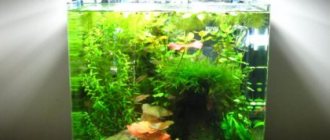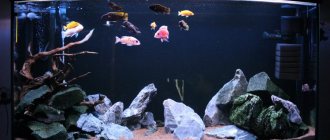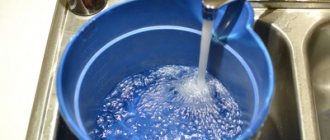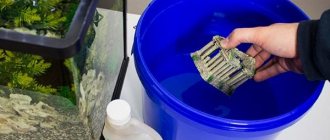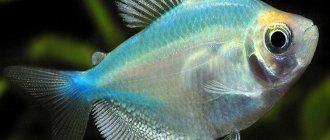Parameters: shape and volume
The cichlid must match the character of the fish, their temperament and lifestyle. The best form is a trough aquarium. The fish constantly furrow the bottom and move through stones and dig holes. This is due to the fact that cichlids are classified as territorial fish. Therefore, if there is insufficient bottom area, the fish will engage in constant skirmishes for territory. The volume of the aquarium depends on how large the breeds you plan to keep.
If the cichlid is stocked with medium-sized fish, then its volume should start from 200 liters. At the same time, it is recommended to place no more than 4 fish in an aquarium of this size. The cichlid should have an elongated shape. You should choose aquariums with a wall length of 90 cm or more. Thanks to this, the territory between the males will be divided in the most rational way.
MYTHS AND LEGENDS OF CICHLID FEEDING
Until now, there is fierce debate among aquarists about the diet of cichlids. Personally, I always adhere to the golden rule - the diet of any type of fish should be balanced.
Cichlids are predators. In addition to dry food, live food (bloodworms, brine shrimp, etc.) and freezing, they happily eat “food from our table.” Many aquarists recommend feeding cichlids (especially large troglodytes) shrimp, squid, chicken, lean meat, ox heart, fish, and even expensive cat food! However, the remark of other aquarists that such foods are not very well absorbed by fish and ultimately lead to cirrhosis of the liver (especially for meat and bovine heart) is appropriate here. In addition, aquarists note that the protein content in bloodworms is an order of magnitude greater than in muscle meat.
With such arguments, you involuntarily agree. After all, no one throws veal into the African rivers Tanganyika and Nyasa, much less cat food!
One conclusion can be drawn here: cichlids can be fed with the above-mentioned “meat” foods, but as a delicacy - rationally (for example, twice a week). Even the largest cichlid should not be transferred exclusively to minced meat. In addition, do not forget about plant nutrition, which many cichlids also respect.
There are many recipes on the Internet for “homemade mixes” for cichlids, which include protein and plant foods, and other necessary elements. Perhaps this is the best option for feeding “from our table”.
As for plant food for cichlids, everything is much simpler. It is best to feed them inexpensive aquarium plants or to specially grow duckweed separately. You can also give scalded lettuce leaves, spinach, green peas, etc.
How much soil do you need?
The amount of soil substrate depends on the amount and type of vegetation, type of substrate, and purpose. Aquarists recommend using a neutral base in small tanks, and periodically adding fertilizer in the form of tablets or drops to feed the plants. It is also better to use fertilizers if there are 2 or 3 plants planted in the aquarium, because the substrate will be excessive and will begin to clog the pond.
In large aquariums and with abundant vegetation, it is better to combine feeding and neutral materials. The minimum thickness should be 3-4 cm. This layer is enough to root the plants. In total, 5-7 cm is enough along with recharge. Plants are planted in the substrate, and neutral quartz or pebbles are laid on top.
Before use, the soil material must be washed in water to remove contamination. The soil needs to be looked after. Periodically it needs to be siphoned to remove residual waste products. Without cleaning, the material can fill the aquarium water, causing cloudiness and algae growth.
Plants need soil in an aquarium for normal growth and development. You cannot plant greens in small quartz stones without feeding. Neutral soil must be fed with fertilizers. To ensure that plants develop and grow well, it is better to consult an experienced aquarist at a pet store. He will select the right soil for your plants.
Decor
The common belief that a cichlid is a naked aquarium with rocks and artificial plants is partly correct. Representatives of this family really like to dig up living plants and spawn on stones. But a caring aquarist will be able to arrange a picturesque design in the aquarium for his pets.
The cichlid acquires a special charm thanks to its massive decorative elements reminiscent of a rocky landscape. Caves, grottoes, broken amphorae will also add a fabulous feel, and driftwood overgrown with plants will perfectly complement the overall aquarium interior with its naturalness.
To divide the container into zones, you can use various decorations and correctly distribute the plants. In a cichlid tank, mounds of stones or driftwood will look especially good, which will also divide the territory for pairs of fish.
DIY grotto
Treat natural materials for the grotto with caution. Do not mine in places with problematic ecology. Do not use stones with “rusty” colored veins. Exceeding the concentration of iron threatens algae thickets and fish poisoning.
Tree species that color the water (oak) are not suitable for an aquarium grotto. The wood should not be rotten: it spoils the water.
Rinse and boil aquarium decorations. There is a risk of infection with pathogenic bacteria and parasites.
Stone structures can be massive. To protect the glass, use weight-distributing stands and place the grotto closer to the aquarium fittings.
From stone
A common option: a shelter made of massive flat stones. If fish are prone to moving decorations or digging (catfish, botia), the elements are fixed with aquarium silicone glue. Plastic colorless sealants (Ceresit, Krass, Tytan, Chemlux) are preferred.
The stones should fit tightly. The structure that has not yet been glued should not fall apart. The larger the surface area, the higher the quality of the seam. Degreasing with acetone or another solvent is mandatory. After gluing and drying, it is necessary to soak in replaceable water for 3–4 days to remove volatile compounds.
Monolithic grottoes are made from soft stones. The advantage is durability. The disadvantage is the complexity of production.
- Limestone is easy to machine. Before placing in the aquarium, it is washed and soaked. Untreated, the pH rises sharply. It releases calcite and increases the carbonate hardness kH of water by 2–6°. Not suitable for soft water.
- Tuff is used in vessels with a hard alkaline environment.
- Sandstone increases water hardness. Has a beneficial effect on plant growth.
- Lava does not affect the composition of the environment, but it is not cheap.
- Shell rock regulates the pH of water. When dissolved, it prevents excessive acidification.
Plants
Plants in a cichlid garden must certainly have endurance and the ability to quickly recover, otherwise they are in danger of rapid death. The main reason for the incompatibility of cichlids and plants is different water parameters. Many cichlids, due to their omnivorous nature, also eat plants, so the task of choosing suitable plants for a cichlid’s aquarium should be approached with special attention. Cichlids are not at all bothered by plants floating on the surface; they like to dig up those planted in the ground. Therefore, it is best to plant plants in pots.
The most common plants for cichlids include the following: Vallisneria tigris and gianta, Echinodorus, Aponogeton ulvoides, Cryptocoryne undulate, Hygrophila willow and polysperm, Brazilian pinnate, Monoselium, nymphea, ferns, Gymnocoronis, Limnophila ambulia. Among the groundcovers, it is optimal to choose dwarf saggitaria, and dwarf anubias can be planted on snags, since this plant grows rather slowly and does not attract the attention of cichlids.
Acidity and water filtration
The cichlid must meet the following parameters: water hardness - from 6 to 12°, pH - 5.8-6.8. Tap water is suitable for filling the aquarium. However, in many regions of the country its acidity levels will vary significantly. The way out of the situation is natural filtration of water, which should be infused in a container with corals, gravel, and shells. A convenient method for bringing acidity parameters back to normal is to add a phosphate buffer. The water in the aquarium must correspond to the temperature parameters of the fish’s natural habitat – 25 degrees.
It is not recommended to place cichlids near heating appliances or windows. Aquarium maintenance experts recommend changing water monthly at a rate of 25%. Fish love moderate lighting, which can be achieved using fluorescent lamps. Cichlid The features of the aquarium are good filtration, since the fish are of impressive size, releasing a lot of organic matter and nitrogen into the water. Filtration ensures uniform distribution of oxygen in all layers. Which is very important for the fish living below.
Caring for fry
Having removed the parents, aquarists keep a vigilant eye on the eggs, waiting for the moment when the neon fry begin to swim. If some of the eggs have died, they are removed from the hatchery using a pipette; it is also recommended to use special antifungal drugs.
After three years, larvae are born and begin to actively swim. Each fry needs to reach the surface of the water in the first hours after birth, so there should be no film on top. The larvae inhale the air needed to form a swim bladder, and after a short time they turn into tiny neon fry.
Babies have poor eyesight, so for feeding, aquarists equip a special light area so that the fry swim towards the light. Pets are first fed ciliates, then transferred to nauplii and cyclops. Gradually, the fish are prepared for relocation to a species aquarium, gradually increasing the water hardness. Four weeks after birth, a neon stripe appears on the body of the fry, and after this the relocation of the fish can begin.
Priming
Registration of a cichlid should begin with the correct choice of soil. Depending on the type of fish, the soil is also selected. For medium-sized inhabitants, sand with a fraction size of 3-5 mm is suitable. This substrate is convenient for cleaning and retains organic particles well. The soil is laid out at a depth of 6-8 cm, which is perfect for planting plants in it. It is also necessary to take into account the color of the soil, which has a direct impact on the condition of the fish. For large cichlids, it is recommended to choose a larger and darker soil.
How to make a grotto for an aquarium from pebbles
This version of the scenery is even more painstaking, but the result is real architectural masterpieces. First, you will need to collect (or buy) a sufficient number of smooth pebbles, preferably brighter colored ones. Then it would be a good idea to sketch out a sketch so that you do not make a mistake with the dimensions, and your grotto would not remain an exceptional landscape decoration. Then the first row is laid out along the intended open curve. The future entrance is fixed with an object of suitable cross-section - a plastic bottle, for example. The pebbles are selected to be approximately the same height. Sealant is applied to them and the next row is laid. When the silicone sets, the next chain is drawn out, and each row should have a slightly smaller internal cross-section to create a rounded structure.
When it comes to the vault, paper is pushed inside the grotto, and the masonry is carried out on top of it. After the silicone has completely hardened, the input clamp and support paper are pulled out.
If you are not lazy and lay out several floors, you will get an exclusive castle for an aquarium, with enough space for all the inhabitants. Before installing it in a permanent place, it is better to soak it for several days in an empty container, changing the water daily.
Decor
The cichlid acquires a special charm thanks to the massive decorative elements. The basis of the design is the rock formations that form the background. The cichlid should have plenty of shelters and caves. The aesthetic accent of the aquarium is driftwood. They come in two types. Branched models look good in a vertical position, so that the upper cut extends beyond the water surface. Compact driftwood perfectly complements the bottom in a horizontal position. Cichlid inhabitants are very sensitive to change, so rearrangements and design updates are highly undesirable.
Selection of fish
Fish from the cichlid family are divided into 3 types:
- originating from African rivers;
- native to Central America;
- from the Amazon.
African cichlids are considered the friendliest. In a 120 liter vessel you can place a pair of Haplochromis multicolor, a pair of parrots and a pair of butterflies in combination with four Ancistrus catfish.
From American cichlids, you can choose a pair of striped cichlases and Sedzhik cichlases, placing them next to a pair of hypostomuses.
An aquarium with Amazonian cichlids should be at least 200 liters. Angelfish can coexist in it with curviceps and maroni cancers. You can add a small group of ancistrus to them.
Launch
Fine sand is placed in the cichlid tank with African fish, and plants are planted densely. But there should also be enough space for swimming. Mounds of stones, caves and pots are used as decoration. In the right conditions, the fish will be able to spawn and thrive.
American cichlids have a more conflicting nature. These pets can do without plants, but if you choose live plants, it is better to opt for more hardy ones such as anubias and Java moss. Flat stones on which fish can lay eggs, and shelters in the form of caves and shells are suitable for decoration.
An aquarium with Amazons requires thickets of plants with free space for the fish to move around. Cryptocoryne and Echinodorus are suitable, since angelfish usually spawn on plant leaves. For other inhabitants you will need caves and stones.
Preparing the spawning tank
In order for pets to reproduce, a nursery with suitable conditions for producing offspring is set up for neons. Building a hatchery for fry with your own hands is not very difficult. A 20 liter container is suitable for six fish; nylon mesh or Java moss is used as a substrate.
Water indicators:
- hardness – up to 4 dH;
- acidity – up to 5 pH;
- temperature – 25–26C.
The water level in the fish tank should be at a distance of 15 cm from the edge of the spawning tank. To adapt, 200 ml of water from the previous aquarium where the fish previously lived is added to the aquarium.
Neons usually begin to reproduce on the same night when settlement occurred, or early in the morning, at dawn. The female lays eggs, and the male fertilizes them, after which the eggs fall onto the substrate. Immediately after breeding, the parents are moved back to preserve the long-awaited offspring. The hatchery with future fry is removed to a dark, secluded place.
Compatibility
There are many opinions about keeping cichlids together with other fish species. And one of the most possible ways of such a combination is a competent approach to the matter. An important rule is to plant cichlids at a younger age, and the rest of the fish, on the contrary, at a more mature age. It is necessary to take into account the aquarium volumes and swimming layers provided for each fish. Veiled cichlids should not be combined with aggressive and biting neighbors such as barbs, swordtails, goldfish, and cockerels. Small and slow fish such as neon and guppies will certainly feed large cichlids.
The cichlid is an amazing type of aquarium, the main feature of which is the combination of fish with a complex character, plants and its harmonious design. Maintaining such an aquarium requires a meticulous approach and compliance with the rules for its care. However, as a result, the owner of a cichlid will get great pleasure from enjoying the underwater fauna created with his own hands, as well as colorful pets with interesting habits.

